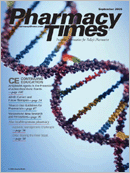Publication
Article
Pharmacy Times
CINV: Beating the Inner Beast
Author(s):
Most patients have one thought in mind when they approach their first chemotherapy session: Will I vomit? Due to significant and welcome advances, many treatment options are available from the pharmacy to prevent or lessen the likelihood of chemotherapy-induced nausea and vomiting (CINV). The American Society of Clinical Oncology (ASCO) recently updated its 1999 evidencebased clinical practice guidelines for antiemetic use.1,2
Nausea is the patient's subjective perception that vomiting is possible; it cannot be measured objectively. Emesis, as defined in clinical studies, is measured by counting the posttreatment number of vomiting episodes. Although nausea correlates with vomiting,3 patients generally experience nausea more frequently than vomiting. Pharmaceuticals can measurably improve emesis.
ASCO defines 4 types of CINV (Table 1). It suggests that clinicians follow patients for CINV for at least 5 days after treatment.
Emetic Risk of Antineoplastic Agents
Antineoplastic agents are grouped by emesis risk, based on available data and experience. ASCO has identified specific antiemetic regimens that correlate with the degree of expected vomiting (Table 2).
When patients are treated with highrisk agents, with cisplatin being the most likely to induce emesis, careful planning is necessary. Research indicates that antiemetics that prevent cisplatin- induced emesis also should work with other high-risk chemotherapy drugs.4
Most cancers, being complex, require combination chemotherapy. Clinicians should prescribe antiemetics that are appropriate for the component agent associated with the greatest emetic risk.
Antiemetics
Clinicians should use a combination of one of the 5-hydroxytryptamine-3 serotonin receptor antagonists (5-HT3 RAs), a corticosteroid (usually dexamethasone), and the substance P/neurokinin 1 (NK1) receptor antagonist aprepitant. Multicenter, randomized studies have confirmed that a combined regimen is safe and highly effective?with few significant adverse effects?and yields the greatest antiemetic protection.5-7
5-HT3 RAs
Five 5-HT3 RAs given in doses with equivalent antiemetic activity and safety profiles are available (Table 2 footnote): dolasetron, granisetron, ondansetron, palonosetron, and tropisetron (in Europe). Their most common adverse events include mild headache, transient asymptomatic serum aminotransferase elevations, and constipation.
Dexamethasone
ASCO recommends that, whenever 5-HT3 RA antiemetics are indicated for the prevention of acute emesis, dexamethasone also should be administered.2 Single daily doses of corticosteroids are used frequently as antiemetics in combination regimens, and they can be used alone in patients receiving chemotherapies with low emetic risk. At equivalent doses, corticosteroids can be used interchangeably to safely prevent emesis.
Although methylprednisolone is used often, inexpensive dexamethasone is available in several formulations. A meta-analysis of 32 randomized trials (with a total of 5613 patients) found dexamethasone superior to placebo and to no treatment for complete protection from acute and delayed emesis.8
Aprepitant
The human brainstem and gastrointestinal tract have many NK1 receptors. When stimulated with substance P, these receptors cause emesis. Agents that block the NK1 receptor subtype prevent vomiting, even when strong stimulants such as cisplatin are used.
Aprepitant is the first FDA-approved NK1 receptor antagonist. It inhibits CYP3A4 moderately. Because the corticosteroids are CYP3A4 substrates, the guidelines recommend lowering dexamethasone doses when aprepitant is given concurrently.9,10
Other Agents
Other agents (metoclopramide, butyrophenones, phenothiazines such as prochlorperazine, and cannabinoids) are reserved for patients who are intolerant of or refractory to recommended therapies. Benzodiazepines, usually lorazepam or alprazolam, and antihistamines such as diphenhydramine and promethazine are useful adjuncts to antiemetics but are not recommended as single agents.11,12
Delayed CINV
Although researchers used to think that only cisplatin caused delayed emesis,12-15 they now know that other chemotherapies can as well.16-18 Preventing emesis in the acute stage is very important. Emesis during the 24 hours after chemotherapy (acute emesis) is a predictor of emesis persisting more than 24 hours after antineoplastic therapy (delayed emesis).12,13,19,20 In these cases, too, dexamethasone, alone and in combination, is preferred.5,6,14,18,20 Dexamethasone usually is administered for 2 to 4 days to avoid adrenal insufficiency. Clinically significant hyperglycemia and insomnia may occur, but rarely.
Aprepitant alone also can prevent delayed emesis.21 Studies have had conflicting results on the ability of 5-HT3 RAs to prevent delayed emesis.16,22-25
Anticipatory Emesis
Patients whose vomiting has been poorly controlled after prior chemotherapy, and especially those with a history of motion sickness, can develop anticipatory or conditioned emesis. They vomit when just thinking about their next treatment cycle.26-31 Clinicians should use the most aggressive antiemetic regimen appropriate for the chemotherapy being administered to prevent acute or delayed emesis. If anticipatory emesis occurs, behavioral therapy with systematic desensitization can be effective. Many clinicians prescribe alprazolam and lorazepam, which are amnestic and anxiolytic, to treat and prevent anticipatory symptoms.
Pediatric CINV
The guidelines address the pediatric oncology population separately. The 5-HT3 RAs plus a corticosteroid have been used in children, but often at higher weight-based doses than those used in adults before antiemetic protection is achieved. Readers who need specific information about pediatric emesis management are referred to the guidelines.
When CINV Persists
Should CINV occur despite aggressive prophylaxis and treatment, clinicians should take 4 steps:
1. Evaluate risk, antiemetic, chemotherapy, tumor, concurrent disease, and medication factors.
2. Verify that the correct regimen is being administered.
3. Consider adding lorazepam or alprazolam.
4. Consider substituting a highdose intravenous metoclopramide for the 5-HT3 RA or adding a dopamine antagonist to the regimen.2
Final Thoughts
In today's clinical setting, one might expect that patients should have no unnecessary CINV. Unfortunately, clinicians still sometimes undertreat patients undergoing moderately or highly emetogenic chemotherapy and overtreat those receiving mildly emetogenic chemotherapy.31 Pharmacists who have a basic understanding of the ASCO guidelines can help patients who are under-or overtreated, thus improving quality of life.
Perhaps someday, chemotherapy will not be associated with vomiting. Unfortunately, the near future holds no such agent.
Dr. Zanni is a psychologist and health-systems consultant based in Alexandria,Va.
For a list of references, send a stamped, self-addressed envelope to: References Department, Attn. A. Rybovic, Pharmacy Times, Ascend Media Healthcare, 103 College Road East, Princeton, NJ 08540; or send an e-mail request to: [email protected]

Newsletter
Stay informed on drug updates, treatment guidelines, and pharmacy practice trends—subscribe to Pharmacy Times for weekly clinical insights.






